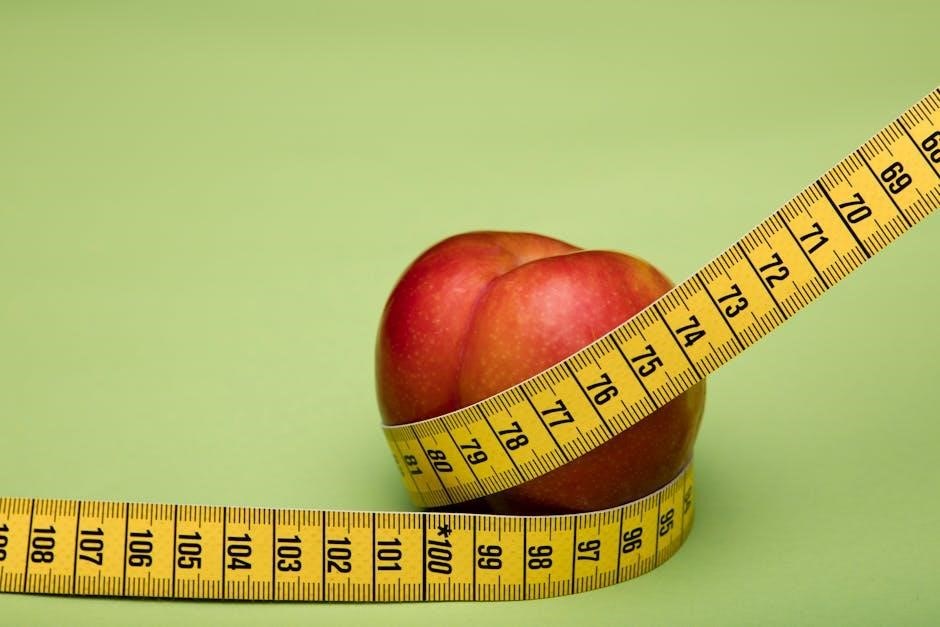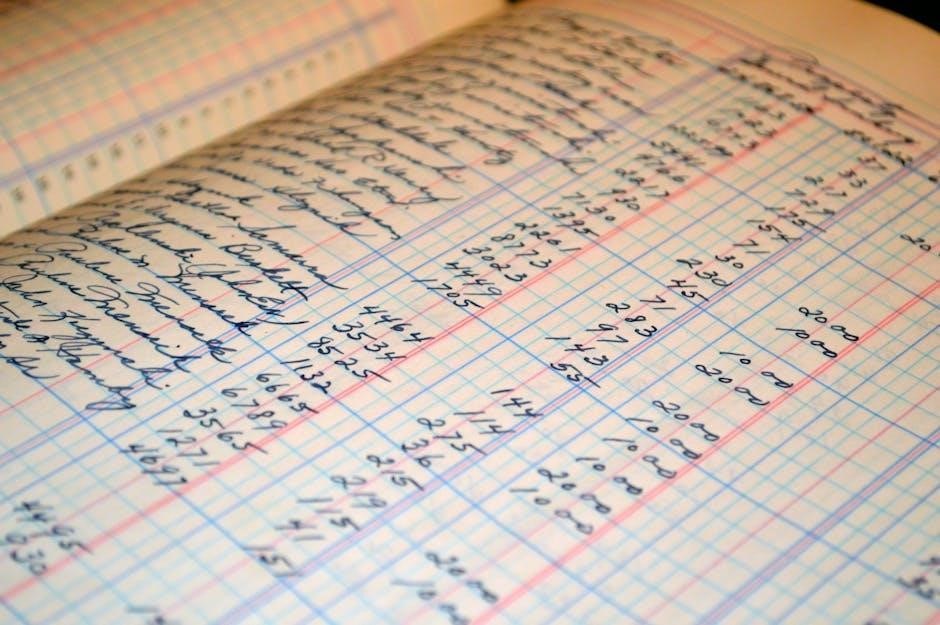A grease fitting, also known as a zerk fitting, is a small but essential component in machinery lubrication systems, enabling efficient grease application to moving parts. Proper sizing is critical for functionality and durability.
1.1 What are Grease Fittings?
Grease fittings, also known as zerk fittings, are small metal components used in machinery to deliver lubricants to moving parts. They consist of a threaded connection and a spring-loaded ball check that seals the fitting when not in use. When a grease gun is applied, the ball is pushed open, allowing grease to flow into the system. These fittings are crucial for maintaining machinery efficiency and preventing wear. They come in various types, such as tapered or straight threads, and are made from materials like steel or brass for durability. Understanding the correct size and thread type is essential for proper installation and function. A grease fitting size chart helps users identify the right fitting for their equipment, ensuring effective lubrication and preventing damage.
1.2 Importance of Grease Fittings in Machinery Lubrication
Grease fittings play a vital role in machinery lubrication by providing a reliable method to deliver lubricants to moving parts. They ensure that grease is applied precisely where needed, preventing wear, corrosion, and overheating. Proper lubrication extends equipment lifespan, reduces maintenance costs, and minimizes downtime. Grease fittings also act as a seal, preventing dirt and contaminants from entering the machinery. Their design allows for efficient grease flow while maintaining a tight seal, ensuring optimal performance. In industries ranging from automotive to heavy-duty manufacturing, grease fittings are essential for maintaining operational efficiency and preventing premature machinery failure. Their importance lies in their ability to protect critical components, ensuring smooth and reliable operation under various conditions.

Understanding Grease Fitting Size Charts
Grease fitting size charts provide standardized measurements for thread diameter, pitch, and length, helping users identify and select the correct fitting for their equipment, ensuring proper fitment and functionality.
2.1 Overview of Grease Fitting Size Charts
Grease fitting size charts are essential tools for identifying the correct dimensions and thread types of grease fittings. These charts provide standardized measurements for thread diameter, pitch, and length, ensuring proper fitment. They categorize fittings by common types, such as tapered (e.g., NPT) and straight thread configurations, and list compatible drill tap sizes. The charts also highlight variations in materials, including zinc-plated steel, stainless steel, and brass, which affect durability and corrosion resistance. By referencing a grease fitting size chart, users can quickly determine the appropriate fitting for their machinery, ensuring efficient lubrication and preventing damage from improper sizing. This resource is invaluable for maintaining equipment reliability and extending the lifespan of moving parts.
2.2 How to Use a Grease Fitting Size Chart Effectively
Using a grease fitting size chart effectively begins with identifying the specific needs of your machinery. Start by measuring the existing fitting or the hole where the fitting will be installed to determine the correct size. Next, refer to the chart to find compatible thread sizes and types, such as NPT or BSPT, ensuring they match your equipment. Consider the material of the fitting, such as zinc-plated steel or brass, based on the application and environmental conditions. Use tools like thread gauges or calipers for accurate measurements if necessary. Finally, follow the chart’s guidelines for installation, including recommended drill tap sizes, to prevent leaks and ensure a secure fit. This systematic approach ensures optimal performance and longevity of your machinery.

How to Read Thread Sizes
Reading thread sizes involves identifying the thread type (tapered or straight) and measuring pitch (threads per inch) and diameter using tools like pitch gauges or calipers. Common types include NPT and BSPT.
3.1 Basics of Thread Measurement
Thread measurement involves determining the pitch, diameter, and type of thread. The pitch is the distance between thread crests, measured in threads per inch (TPI). Diameter is the major thread’s width. Tools like pitch gauges and calipers are essential for accurate measurements. Tapered threads narrow slightly, while straight threads remain uniform. Common types include NPT (National Pipe Taper) and BSPT (British Standard Pipe Taper). Proper measurement ensures correct fitting installation and compatibility, preventing leaks or damage. Using a thread gauge simplifies identification, but visual inspection for taper or parallel threads can also help determine the type. Accurate measurement is crucial for selecting the right grease fitting. Always refer to a size chart for precise fitting specifications. Regular maintenance of threads ensures optimal performance and longevity of machinery.
3.2 Common Thread Types (NPT, BSPT, Metric, etc.)
Grease fittings are available in various thread types to suit different applications. The National Pipe Taper (NPT) thread is widely used in the U.S., featuring a tapered design that creates a seal when threaded. British Standard Pipe Taper (BSPT) is similar but has a slightly different angle. Metric threads, measured in millimeters, are common in international applications. Other types include UN/UNF (Unified National/Unified National Fine) and BSPP (British Standard Pipe Parallel). Each thread type has specific pitch and diameter measurements, detailed in size charts. Correct identification ensures compatibility and proper sealing. Using a thread gauge or chart helps determine the exact type and size, crucial for effective lubrication. Proper thread selection prevents leaks and ensures optimal machinery performance. Always verify thread type with equipment specifications for accurate fitting installation. Regular inspection and maintenance of threads are essential for longevity.

Types of Grease Fittings
Grease fittings vary in design, including tapered, straight, flush, and button head types. Materials range from stainless steel to monel, offering durability and corrosion resistance for diverse applications.
4.1 Tapered vs. Straight Thread Fittings
Tapered thread fittings, such as the 1/8 NPT, feature a diameter that narrows towards the tip, creating a tight seal. They are commonly used in automotive applications for their secure connections. Straight thread fittings, in contrast, have a consistent diameter and are often found in industrial equipment. The choice between tapered and straight threads depends on the specific machinery and the desired seal type. Tapered threads provide a more robust connection, while straight threads offer easier installation and removal. Both types are widely available in various sizes, as outlined in grease fitting size charts, ensuring compatibility with different equipment needs. Proper selection is crucial for effective lubrication and machinery performance.
4.2 Flush Type and Other Specialty Fittings
Flush type grease fittings are designed to sit evenly with the surface they are installed on, making them ideal for applications where protruding fittings could be damaged or obstructive. These fittings are commonly used in rotating components like pulleys and shafts. Other specialty fittings include button head, hydraulic shut-off, and pressure relief types, each tailored for specific uses. Button head fittings are suited for high-pressure applications, while hydraulic shut-off fittings prevent over-greasing by restricting flow at certain pressures. Pressure relief fittings act as vents to release excess pressure in bearing housings or gearboxes. Specialty fittings are often made from durable materials like stainless steel or Monel, offering enhanced corrosion resistance. Selecting the right type depends on the application, environmental conditions, and machinery requirements, ensuring optimal performance and longevity.

How to Choose the Right Grease Fitting
Selecting the right grease fitting involves determining the correct size, thread type, and material based on the application and equipment requirements to ensure proper lubrication and durability.
5.1 Determining the Correct Fitting Size
Determining the correct grease fitting size involves measuring the thread diameter, pitch, and length. Use a thread gauge to identify the type and size accurately. Refer to a grease fitting size chart to match the measurements with the appropriate fitting. Common sizes include 1/8 NPT and metric threads. Ensure the fitting’s pressure rating meets the application’s demands. Proper sizing prevents leaks and ensures efficient lubrication. Always consult the equipment’s manual for specific recommendations. Using the wrong size can lead to functionality issues or damage. Measure carefully and cross-reference with the chart to select the ideal fitting for your machinery.
5.2 Selecting the Appropriate Material and Type
Selecting the right material and type of grease fitting is crucial for optimal performance and longevity. Common materials include stainless steel, carbon steel, brass, and monel, each offering unique benefits such as corrosion resistance or durability. Stainless steel fittings are ideal for harsh environments, while monel excels in marine applications. Grease fittings also come in various types, such as tapered, straight, flush, and hydraulic shut-off, catering to specific needs. Flush fittings are suitable for rotating machinery, while hydraulic shut-off fittings prevent over-greasing. Specialty types like pin or leakproof fittings are designed for high-pressure or sealed environments. Always consider the application, environmental conditions, and equipment requirements when choosing. Refer to a grease fitting size chart to ensure compatibility and optimal functionality.

Common Applications of Grease Fittings
Grease fittings are widely used in automotive, industrial, and heavy-duty machinery to lubricate bearings and moving parts, ensuring smooth operation and longevity in various mechanical systems and equipment.
6.1 Automotive and Commercial Machinery Usage
Grease fittings are integral in automotive and commercial machinery, facilitating lubrication of moving parts like bearings, joints, and gears. In vehicles, they are commonly found in suspension systems, steering components, and axles. Proper sizing, as indicated by a grease fitting size chart, ensures efficient lubrication and prevents wear. Commercial machinery, such as construction equipment and agricultural vehicles, also relies heavily on these fittings to maintain performance and durability. Using the right size and type of grease fitting is crucial to avoid damage and ensure optimal operation in demanding environments. Regular maintenance and inspection of these fittings are essential to prevent clogging and ensure smooth functionality over time.
6.2 Industrial and Heavy-Duty Applications
Grease fittings play a pivotal role in heavy-duty industrial settings, ensuring the smooth operation of large machinery and equipment. In manufacturing and construction, these fittings are used to lubricate bearings, gears, and other critical components exposed to high stress and wear. Industrial applications often require specialized grease fittings, such as metric or tapered thread types, to withstand extreme conditions like heavy loads and corrosive environments. Stainless steel or high-pressure fittings are commonly used in these scenarios for durability. Proper sizing, as determined by a grease fitting size chart, is essential to prevent downtime and ensure optimal performance. Regular maintenance of these fittings is crucial to avoid clogging and maintain production efficiency. Their reliability is key to safeguarding industrial operations and ensuring worker safety in demanding environments.
Tools for Identifying Grease Fitting Threads
Thread gauges and calipers are essential for measuring thread diameters, while pitch gauges determine thread spacing. These tools help identify grease fitting threads accurately for proper selection.
7.1 Using a Thread Gauge
A thread gauge is a precise tool designed to measure and identify the thread type and size of grease fittings. It includes various standard metric and American thread sizes, such as UNF and NPT. By aligning the gauge with the fitting’s threads, users can quickly determine the correct size. This tool is especially useful for distinguishing between parallel and tapered threads, as well as measuring thread pitch. Using a thread gauge ensures accurate identification, preventing mismatches that could lead to leaks or damage. It is a time-saving solution for mechanics and technicians working with grease fittings in automotive and industrial applications. Regular use of a thread gauge helps maintain equipment efficiency and longevity.
7.2 Calipers and Pitch Gauges for Measurement
Calipers and pitch gauges are essential tools for accurately measuring grease fitting threads when a thread gauge is unavailable; Calipers measure the external thread diameter by placing the lower jaw at the zero mark on the fitting. Pitch gauges determine the thread pitch by comparing the distance between thread crests. These tools help identify whether the thread is parallel or tapered and match it to the correct size. Using calipers and pitch gauges ensures precise measurements, reducing errors in fitting selection. While grease fitting size charts provide standardized measurements, physical verification with these tools is crucial for accuracy. Combining calipers, pitch gauges, and a thread gauge ensures reliable identification of thread types and sizes, preventing installation issues and equipment damage.

Maintenance and Troubleshooting
Regular cleaning and inspection of grease fittings are crucial to prevent clogs and damage. If a fitting fails to accept grease, inspect for blockages or damage, replacing it if necessary.
8.1 Cleaning and Maintaining Grease Fittings
Cleaning and maintaining grease fittings are essential to ensure optimal performance and longevity. Start by using a clean cloth or brush to remove dirt, grime, or old grease from the fitting’s surface. This prevents contaminants from entering the system when lubricating. Next, inspect the fitting for any signs of damage or wear, such as cracks or corrosion. If damage is found, replace the fitting immediately to avoid machinery breakdowns. Regularly lubricate the fitting itself to keep it functioning smoothly. Additionally, avoid mixing old and new grease, as this can lead to degraded lubricant quality. Always ensure the fitting is free from debris before attaching a grease gun to prevent clogs. Proper maintenance not only extends the life of the fitting but also ensures effective lubrication of connected machinery components.
8.2 Solving Common Issues with Grease Fittings
Common issues with grease fittings often stem from improper maintenance or installation. One frequent problem is clogging due to dirt or hardened grease, which can prevent lubricant flow. To resolve this, clean the fitting thoroughly with a solvent and ensure it is free from debris before use. If the grease gun becomes stuck, it may be due to over-tightening or blockages. Loosen the connection carefully and check for obstructions. Another issue is leakage, which can occur from worn or damaged seals. Inspect the fitting for wear and replace any faulty components. Proper alignment and tightening of the grease gun coupler can also prevent leaks. Regular inspection and maintenance, as outlined in the grease fitting size chart, can help identify and address these issues early, ensuring smooth operation and extending the lifespan of both the fitting and connected machinery.

Industry-Specific Usage of Grease Fittings
Grease fittings are widely used in automotive, industrial, and heavy-duty applications. Their size charts help in selecting the right fitting for specific machinery, ensuring optimal performance across industries.
9.1 Grease Fittings in Automotive Industries
In the automotive sector, grease fittings play a pivotal role in maintaining vehicle efficiency and longevity. They are commonly found in components such as steering systems, wheel bearings, and suspension parts. The use of appropriate grease fitting sizes, as determined by a size chart, ensures proper lubrication without over-application. Automotive industries rely on standardized fittings like the 1/8 NPT tapered thread, which is widely used for its reliability and compatibility with most grease guns. Regular maintenance using these fittings helps prevent wear and tear, reducing the risk of mechanical failure. The automotive industry’s demand for durable and precise grease fittings has led to the development of specialized materials and coatings, enhancing resistance to corrosion and extreme temperatures. This ensures that grease fittings can withstand the harsh conditions often encountered in automotive applications, making them an indispensable tool for mechanics and technicians.
9.2 Specialized Fittings for Industrial Equipment
Industrial equipment often requires specialized grease fittings to handle demanding operational conditions. These fittings are designed to withstand high-pressure applications, extreme temperatures, and corrosive environments. Metric grease fittings, for instance, are widely used in industrial machinery due to their durability and resistance to wear. Flush-type fittings are ideal for applications where protruding fittings could be problematic, such as in rotating shafts or pulleys. Hydraulic shut-off fittings are another specialized option, preventing over-greasing and maintaining optimal lubrication levels. Stainless steel and Monel fittings are commonly employed in industrial settings for their corrosion resistance. A grease fitting size chart is essential for selecting the right fitting, ensuring compatibility with the equipment and the specific demands of the application. Proper sizing and material selection are critical to maintaining equipment performance and longevity in industrial environments.

Installation Guide for Grease Fittings
Ensure proper installation by using a thread gauge to identify fitting sizes. Drill and tap holes according to the grease fitting size chart for precise alignment. Clean the area before installing the fitting, then use a grease gun to apply lubricant. Avoid over-tightening to prevent damage to threads or equipment.
10.1 Step-by-Step Installation Process
Begin by ensuring the area is clean and free of debris. Use a thread gauge to measure the fitting’s threads, ensuring compatibility with your machinery. consult the grease fitting size chart to determine the correct drill bit size for the hole. Drill the hole carefully, then tap the threads using the appropriate tap (tapered or straight). Insert the grease fitting into the tapped hole, tightening it securely without over-tightening. Finally, test the fitting by applying grease with a grease gun to ensure proper function and no leaks;
10.2 Tips for Preventing Leaks and Damage
To prevent leaks and damage during grease fitting installation, ensure the area is clean and free of debris. Use a thread gauge to confirm the fitting’s compatibility with the machinery. Avoid over-tightening, as this can damage threads or the fitting itself. Apply a small amount of lubricant to the threads before installation to reduce friction. Properly align the fitting to avoid uneven wear. Use materials resistant to corrosion, such as stainless steel or brass, for durability. Regularly inspect and clean the fitting to prevent clogs. Finally, use a grease gun correctly, applying steady pressure without forcing it, to avoid damaging the fitting or causing leaks.

Best Practices for Using Grease Fittings
Always use the correct grease fitting size from the chart to ensure compatibility. Clean the area before installation to prevent contamination. Avoid over-tightening to prevent thread damage. Use compatible materials and ensure proper alignment for optimal performance. Regularly inspect and maintain fittings to avoid clogs or leaks, ensuring smooth machinery operation.
11.1 Proper Lubrication Techniques
Proper lubrication techniques are essential for maintaining machinery efficiency and longevity. Always refer to a grease fitting size chart to ensure the correct fitting size for your equipment. Clean the grease fitting and surrounding area before applying grease to prevent contamination. Use a grease gun with the correct pressure setting to avoid overfilling, which can damage seals or bearings. Apply grease in small, controlled amounts, checking for any signs of leakage or improper flow. Regularly inspect the fitting for wear or damage, replacing it if necessary. Proper lubrication not only extends equipment life but also prevents premature wear and downtime.
11.2 Safety Precautions When Handling Grease Fittings
When handling grease fittings, safety is paramount to prevent accidents and ensure smooth machinery operation. Always wear protective gloves and eyewear to shield against grease splatters and debris. Ensure the work area is clean and free from hazards to avoid slips or trips. Avoid over-tightening fittings, as this can damage threads or cause equipment failure. Never use excessive force or improper tools, which may lead to fitting breakage. Keep grease guns and fittings away from open flames or sparks, as grease can ignite under high heat. Regularly inspect grease guns and fittings for wear or damage, replacing them if necessary. Properly dispose of used grease and cleaning materials to prevent environmental contamination. Adhering to these precautions ensures a safe and efficient lubrication process.
Grease fitting size charts are essential for proper lubrication, ensuring machinery efficiency and longevity. Correct sizing and maintenance are vital to prevent damage and ensure optimal performance.
12.1 Summary of Key Points
Grease fitting size charts are indispensable tools for ensuring proper lubrication in machinery. They provide standardized measurements for thread diameter, pitch, and length, aiding in the selection of the correct fitting. Proper sizing is crucial to prevent leaks and damage, while appropriate materials like stainless steel or brass enhance durability. Regular maintenance, such as cleaning and inspecting fittings, is essential for optimal performance. Misuse or incorrect sizing can lead to machinery failure, emphasizing the importance of understanding thread types and using tools like thread gauges. By adhering to best practices and using resources like grease fitting size charts, users can ensure efficient and reliable lubrication systems. These charts are readily available in PDF formats for easy reference.
12.2 Importance of Proper Grease Fitting Selection and Maintenance
Proper selection and maintenance of grease fittings are vital for ensuring machinery efficiency and longevity. Using the correct fitting size prevents leaks and damage, while regular cleaning and inspection maintain functionality. Incorrectly sized or poorly maintained fittings can lead to equipment failure, downtime, and increased costs. A grease fitting size chart helps in accurate selection, reducing the risk of errors. Additionally, understanding thread types and materials ensures compatibility with machinery, avoiding potential damage. Proper maintenance involves cleaning before use and replacing damaged fittings promptly. This not only enhances performance but also safeguards against contamination and wear. By prioritizing correct selection and upkeep, users can optimize lubrication processes, reduce maintenance needs, and extend equipment life, ultimately contributing to operational efficiency and cost savings.